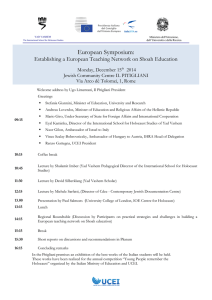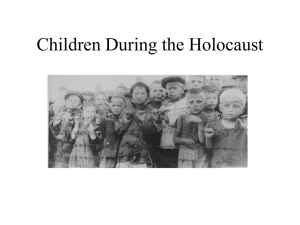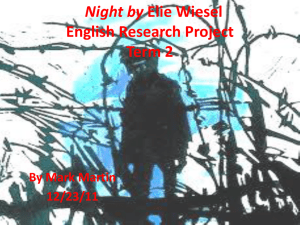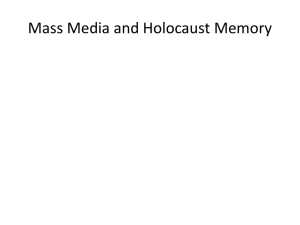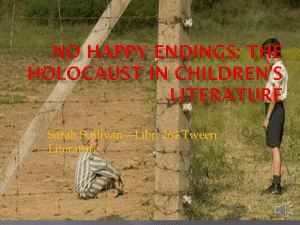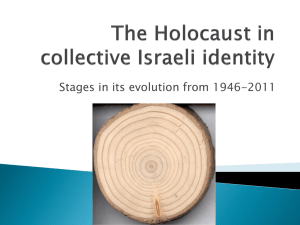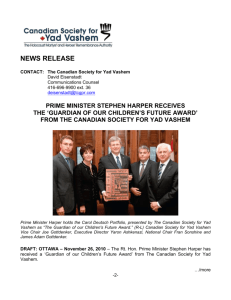Elective 1 Introduction to History and Memory
advertisement
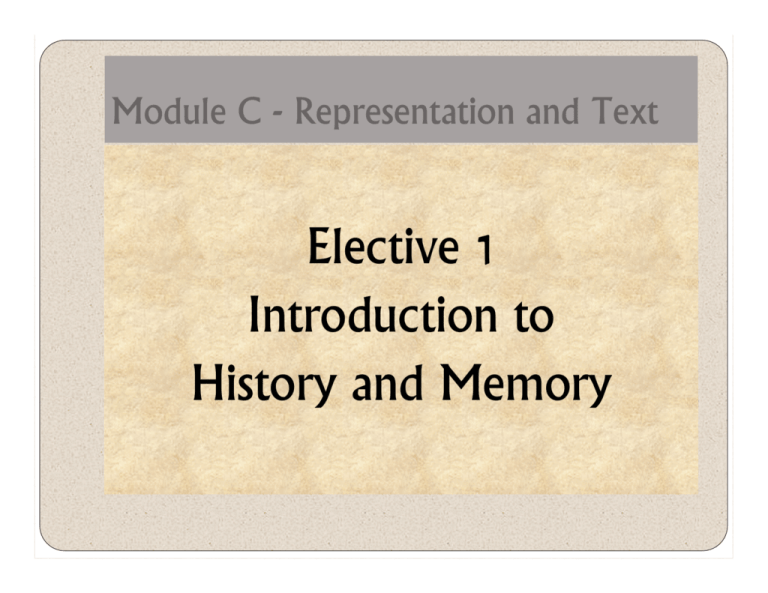
Module C Representation and Text Elective 1 Introduction to History and Memory Representation and Text The NSW Board of Studies Syllabus (page 22) for this module states: This module requires you to explore various representations of events, personalities or situations. You will evaluate how medium of production, textual form, perspective and choice of language influence meaning. The study develops your understanding of the relationships between representation and meaning. Representation and Text Each elective in this module requires the study of one prescribed text offering a representation of an event, personality or situation. You are also required to supplement this study with texts of your own choosing which provide a variety of representations of that event, personality or situation. These texts are to be drawn from a variety of sources, in a range of genres and media. Representation and Text You will explore the ways in which different media present information and ideas to understand how various textual forms and their media of production offer different versions and perspectives for a range of audiences and purposes. History and Memory In your responding and composing, you must consider The Fiftieth Gate (prescribed text) and other texts which explore the relationships between individual memory and documented events. You will analyse and evaluate the interplay of personal experience, memory and documented evidence to broaden your understanding of how history and personal history are shaped and represented. The prescribed text The author: Mark Raphael Baker Born in 1959 in Melbourne Doctorate from Oxford Lectures in Modern Jewish University Editor of Generation: A Journal of Australian Jewish Life and Thought Son of Holocaust survivors lives in Victoria with his wife and three children History at the University of Melbourne. The Fiftieth Gate Explores some of the historical events surrounding the Holocaust and the post-war experiences of the Baker family Uses a range of styles to create Baker’s version of this event Is subtitled ‘A JOURNEY THROUGH MEMORY’ What was the Holocaust? What was ‘The Holocaust’ The Holocaust was the murder by Nazi Germany of six million Jews. While the Nazi persecution of the Jews began in 1933, the mass murder was committed during World War II. It took the Germans and their accomplices four and a half years to murder six million Jews. They were at their most efficient from April to November 1942 – 250 days in which they murdered some two and a half million Jews. They never showed any restraint, they slowed down only when they began to run out of Jews to kill, and they only stopped when the Allies defeated them. (Yad Vashem www.yadvashem.org.il) Where did some the historical events of The Holocaust occur? This animated map showing major periods of the Holocaust and is a useful overview to the events of the Holocaust http://www.ushmm.org/wlc/en/media_nm.php?ModuleId =10005143&MediaId=3372 Animated map (Source: United States Holocaust Memorial Museum www.ushmm.org) Extermination camps Extermination camps were killing centers designed to carry out genocide. Between 1941 and 1945, the Nazis established six extermination camps in former Polish territory--Chelmno, Belzec, Sobibor, Treblinka, Auschwitz-Birkenau (part of the Auschwitz complex), and Majdanek. Chelmno and Auschwitz were established in areas annexed to Germany in 1939. The other camps (Belzec, Sobibor, Treblinka, and Majdanek) were established in the Generalgouvernement (General Government) of Poland. Both Auschwitz and Majdanek functioned as concentration and forced-labor camps as well as killing centers. The overwhelming majority of the victims of the extermination camps were Jews. An estimated 3.5 million Jews were killed in these six extermination camps as part of the Final Solution. Other victims included Roma (Gypsies) and Soviet prisoners of war. (Source: Jewish Virtual Library www.jewishvirtuallibrary.org) Extermination Camps What is ‘The Fiftieth Gate’? In Jewish mysticism, it is believed that there are fortynine gates that separate good from evil. They are gates in our hearts. Beyond them, lies a fiftieth gate, the point at which we stop moving but become aware of who we are. It is the gate we pass through when we say ′I am′. – The Fiftieth Gate The Fiftieth Gate is about... Mark Raphael Baker’s personal story of his reactions to learning about the experiences of his parents during the Holocaust. The historical events he researched surrounding the persecution of the Jews in the areas of Poland in which his parents grew up during WWII The testimony of his father: Yossl, who was imprisoned in some of the most notorious concentration camps The testimony of his mother, Genia, who was forced to hide for several years once the Jews of her village had been murdered. Baker’s efforts to verify his parents’ testimonies The relationship between Baker and his parents as he probes their past. The experiences of Baker and his parents when they (re) visit the villages and death camps familiar to his parents Issues raised in The Fiftieth Gate The power of traumatic experience in shaping a person′s life The experiences of Jewish refugees in Australia after the Second World War The struggle of the children of Holocaust survivors to understand, respect and move on from their parents′ experiences The cultural life of Jewish Australians The effect of the Holocaust on Jewish thought, culture and community The role of memory and remembrance (From Harper Collins Reading Guide: The Fiftieth Gate Structure and Style essentially a biography of Baker′s parents narrated by its author, Mark Baker Subtitled, ′A Journey through Memory′ which suggests, the book is comprised of reminiscences from his parents about their lives and experiences during the 1930s and 1940s Baker, a Melbourne academic, supplements their stories with material from his own research heavy accents of his parents conveyed in his spelling no authorial distance between Baker and the material he records includes documents from his research in the book Includes reconstructions of events Includes records of his parents speaking about their memories on tape and records of his conversations with them (From Harper Collins Reading Guide: The Fiftieth Gate www.harpercollins.com.au) ‘Valley of Communities’ Yad Vashem Mark Baker conducts some of his research at Yad Vashem, the Israeli Holocaust Martyrs and Heroes Remembrance Authority in Jerusalem, Israel. He also travels with his parents and other Holocaust survivors to Yad Vashem. The Valley of Communities, commemorates the destroyed Jewish communities of Europe. ‘The Valley’ is designed to replicate the layout and location of many of the European Jewish communities which existed before the Holocaust. It is a memorial to history and memory. Possible Related Texts Remember, the texts do not have to be about The Holocaust, but about the relationship between History and Memory Focus on how the texts influence the response of responder who has no connection to the event Aim for a variety of sources, in a range of genres and media Examples could include – Memoir/autobiography Fiction Film Poetry Magazine article Documentary Websites Interviews TV series Some Written texts Night by Eli Wiesel. (a memoir) If this is a man by Primo Levi (a memoir) The Diary of Anne Frank (a diary) Fateless Imre Kertesz (a memoir) Klata′s Diary by Zlata Filipovic Davita′s Harp by Chaim Potok The Devil’s Arithmetic by Jane Yolen Authors - Araon Appelfeld, Ida Fink Poets Dan Pagis (whose poem ‘Written in Pencil in the Sealed Freightcar’ is in ‘The Fiftieth Gate’) “I attempted not only to portray the horror but also to confront it and somehow remain alive” Cattle car used to transport victims to the camps, now at Yad Vashem, Jerusalem Arye Palgi Primo Levi Paul Celan “When I read my poems, they grant me, momentarily, the possibility to exist, to stand” Film Schindler′s List by Steven Spielberg (1993) The Pianist by Roman Polanski (2002) Fateless by Laos Koltai (2005) Everything is Illuminated by Live Schreiber (2005) Europa, Europa by Agnieska Holland (1990 ) The Killing Fields by Roland Joffe (1984) (about the Khmer Rouge in Cambodia) Rabbit Proof Fence by Phillip Noyce (about the Stolen Generation) Documentary and TV Shoah (developed from filmed interviews with survivors), can be found on Youtube Band of Brothers Websites Yad Vashem:The Israeli Holocaust Martyrs’ and Heroes’ Remembrance Authority www.yadvashem.org.il The United States Holocaust Memorial Museum www.ushmm.org The Simon Wiesenthal Centre www.wiesenthal.com/index.html The Anne Frank House Memorial and Museum in Amsterdam www.annefrank.nl Yad Vashem Museum The Yad Vashem website contains a variety of representations of the museum. This site is well worth investigating for the wealth of materials available for student investigation and analysis. Art Henri Pieck (1895-1972) Hellmut Bachrach-Baré (1898-1969) Related Materials in this Resource Guide Magazine article: ‘I, Too had a Face’ by Avner Shalev in Yad Vashem Magazine http://www1.yadvashem.org/about_yad/magazine/magazine_new/mag_ 31/index_museum_31.html (Appendix 1) Poem: ‘To Forget’ Ayre Palgi (Appendix 2) Museum: Sydney Jewish Museum http://www.sydneyjewishmuseum.com.au/ (Appendix 3) Webpage ‘The Hall of Names’ www.yadvashem.org.il (Appendix 4) Speech by Elie Wiesel, ‘The Perils of Indifference’ found at ‘The History Place – Great Speeches’ http://historyplace.com/speeches/wiesel.htm (Appendix 5) Sample Extended Response Questions How does individual memory play a role in our attempts to improve our understanding of the past? In your answer refer to the understanding of History and Memory you have gained form your prescribed text and at least TWO related texts of your own choosing. Discuss the representation of a personality, event or situation in your prescribed text and TWO related texts of your own choosing. Sample introductions are attached to this unit Compiled by Bridget Punch John Paul College Coffs Harbour For the Gandel Holocaust Studies Program for Australian Educators 2010
